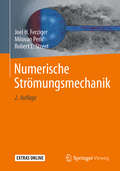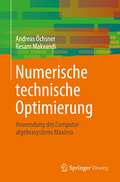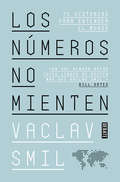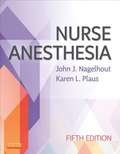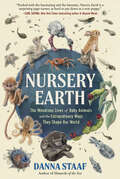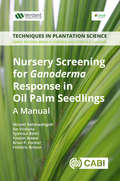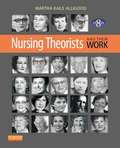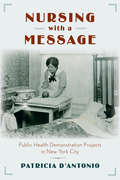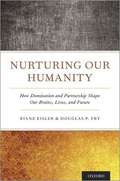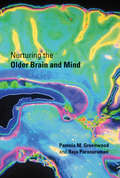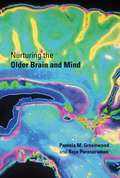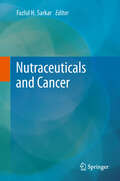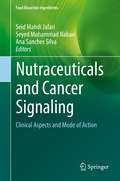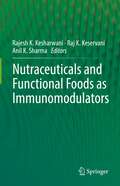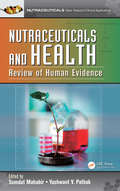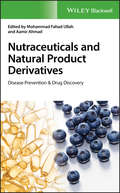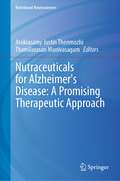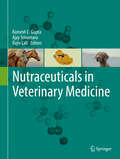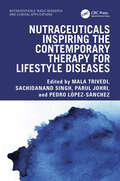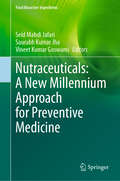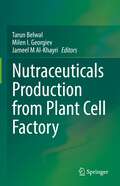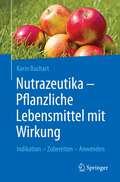- Table View
- List View
Numerische Methoden der Technischen Akustik (Fachwissen Technische Akustik)
by Michael Möser Gerhard MüllerDieser Band der Reihe Fachwissen Technische Akustik behandelt die am weitesten verbreiteten, wellentheoretischen Verfahren der numerischen Akustik. Die Randelementemethode, die Finite-Elemente-Methode und die Ersatzstrahlermethode werden in den Kapiteln ausführlich behandelt. Weitere Methoden wie z. B. Approximationen für hohe Frequenzen, Verfahren der geometrischen Akustik oder die statistische Energieanalyse werden ebenfalls kurz angesprochen.
Numerische Strömungsmechanik
by Joel H. Ferziger Milovan Perić Robert L. StreetDieses Buch behandelt numerische Methoden zur Lösung fluiddynamischer Probleme. Die gängigsten Diskretisierungs- und Lösungsmethoden, die auch in den meisten kommerziellen Programmen zu finden sind, werden ausführlich beschrieben. Einige fortgeschrittene Themen, wie bewegliche Gitter, Simulation von Turbulenz, Berechnung von Strömungen mit freien Oberflächen, Mehrgitterverfahren und paralleles Rechnen, werden ebenfalls behandelt. Da dies ein sehr weites Feld ist, werden nur die grundlegenden Methoden und Ideen, auf denen fortgeschrittene Techniken aufgebaut sind, ausführlich beschrieben. Die Theorie wird durch einige anschauliche Beispiele untermauert. Numerische Genauigkeit und Fehlerabschätzung sind wichtige Aspekte und werden in vielen Beispielen diskutiert. Rechenprogramme, die viele der im Buch beschriebenen Methoden enthalten, können von der Homepage www.cfd-peric.de. bezogen werden. Die 2. Auflage enthält eine umfassende Überarbeitung aller Kapitel; einige neue Methoden werden beschrieben und Verweise auf neuere Publikationen mit neuen Ansätzen sind enthalten. Das ehemalige Kapitel 7 über die Lösung der Navier-Stokes-Gleichungen wurde in zwei Kapitel aufgeteilt, um eine detailliertere Beschreibung mehrerer Varianten der Fractional-Step-Methode und einen Vergleich mit SIMPLE-artigen Ansätzen zu ermöglichen. In den Kapiteln 7 bis 13 wurden die meisten Beispiele ersetzt oder neu berechnet, mit Hinweisen auf praktische Anwendungen. Mehrere neue Abschnitte wurden hinzugefügt, um z.B. die Behandlung von überlappenden Gittern, Fluid-Struktur-Wechselwirkung und Wärmeübertragung abzudecken.Dieses Buch richtet sich an Studierende, die einen Kurs über Berechnungsmethoden in der Strömungsmechanik besuchen, und Anwender kommerzieller CFD-Software, für die es nützlich ist, weil es die in Softwarehandbüchern enthaltenen Informationen ergänzt.
Numerische technische Optimierung: Anwendung des Computeralgebrasystems Maxima
by Andreas Öchsner Resam MakvandiDiese Studienhilfe zu numerischen Optimierungsverfahren richtet sich an Studierende des Maschinenbaus im Grundstudium und im Hauptstudium. Optimierungsverfahren gewinnen zunehmend an Bedeutung für den Leichtbau, wo eine Gewichtsreduzierung z.B. im Automobilbau oder in der Luft- und Raumfahrtindustrie zu einem geringeren Kraftstoffverbrauch und einer entsprechenden Senkung der Betriebskosten sowie zu positiven Auswirkungen auf die Umwelt führen kann. Basierend auf dem freien Computeralgebrasystem Maxima stellen die Autoren Verfahren zur numerischen Lösung ingenieurmathematischer Probleme sowie Anwendungen aus traditionellen Lehrveranstaltungen zur Festigkeit von Werkstoffen vor. Die mechanischen Theorien konzentrieren sich auf die typischen eindimensionalen Strukturelemente, d.h. Federn, Stäbe und Euler-Bernoulli-Balken, um die Komplexität des numerischen Rahmens zu reduzieren und den resultierenden Entwurf auf eine geringe Anzahl von Variablen zu beschränken. Die Verwendung eines Computeralgebrasystems und der darin enthaltenen Funktionen, z. B. für Ableitungen oder Gleichungslösungen, ermöglicht eine stärkere Konzentration auf die Methodik der Optimierungsverfahren und nicht auf Standardverfahren.Das Buch enthält auch zahlreiche Beispiele, darunter einige, die mit Hilfe eines grafischen Ansatzes gelöst werden können, um dem Leser ein besseres Verständnis der Computerimplementierung zu vermitteln.
Los números no mienten: 71 historias para entender el mundo
by Vaclav SmilUn maestro de los datos y las estadísticas ofrece una visión del mundo tan sorprendente como iluminadora. ¿Es peligroso volar? ¿Qué es peor para el medioambiente, un coche o un móvil? ¿Cuánto pesan todas las vacas del mundo juntos y por qué ese dato importa? ¿Se puede medir la felicidad? La misión de Vaclav Smil es convencernos de que los hechos importan. Científico medioambiental, analista de políticas públicas y autor tremendamente prolífico, es el referente de Bill Gates cuando se trata de entender el mundo. En Los números no mienten, nos embarcamos con Smil en una fascinante expedición en busca de datos que desafían nuestras preconcepciones, al tiempo que nos invita a ver con nuevos ojos el impacto de las transformaciones del mundo moderno sobre la sociedad y el medioambiente. Basado en divertidos ejemplos, estadísticas y gráficas asombrosas, este libro es la combinación perfecta de ingenio, historia y ciencia quecambiará la manera en que vemos el mundo. Es posible que los números no mientan, pero ¿qué verdad transmiten? La crítica ha dicho...«El título de Smil lo dice todo: para entender el mundo hay que examinar las líneas de tendencia, no los titulares. Un retrato fascinante, convincente y sobre todo realista del mundo actual y de hacía dónde nos dirigimos.»Steven Pinker «La palabra "erudito" se inventó para describir a gente como él.»Bill Gates «Uno de los pensadores más importantes del mundo sobre la historia del desarrollo y un maestro del análisis estadístico.»The Guardian
Nurse Anesthesia 5th edition
by John J. Nagelhout Karen L. PlausWritten specifically for nurse anesthetists, Nurse Anesthesia, 5th Edition provides comprehensive coverage of both scientific principles and evidence-based practice. It offers a complete overview of anatomy, physiology, pharmacology, and pathophysiology, and offers practical coverage of equipment and anesthesia management.
Nursery Earth: The Wondrous Lives Of Baby Animals And The Extraordinary Ways They Shape Our World
by Danna StaafFrom the author of Monarchs of the Sea, a first-of-its-kind journey into the hidden world of baby animals—hailed as “a gobsmacking delight!” (Sy Montgomery, New York Times–bestselling author of The Soul of an Octopus) It’s time to pay attention to baby animals. From egg to tadpole, chick to fledgling, they offer scientists a window into questions of immense importance: How do genes influence health? Which environmental factors support—or obstruct—life? Entire ecosystems rest on the shoulders (or tentacles, or jointed exoskeletons) of animal babies. At any given moment, babies represent the majority of animal life on Earth. In Nursery Earth, researcher Danna Staaf invites readers into the sibling (and, sometimes, clashing) fields of ecology and developmental biology. The tiny, hidden lives that these scientists study in the lab and in the wild reveal some of nature’s strangest workings: A salamander embryo breathes with the help of algae inside its cells. The young grub of a Goliath beetle dwarfs its parents. The spotted beak of a parasitic baby bird tricks adults of other species into feeding it. Mouse embryos can absorb cancerous cell grafts—and develop into healthy adults. Our bias toward adult animals (not least because babies can be hard to find) means these wonders have long gone under-researched. But for all kinds of animals, if we overlook their babies, we miss out on the most fascinating—and consequential—time in the lives of their species. Nursery Earth makes the case that these young creatures are not just beings in progress but beings in their own right. And our planet needs them all: the maggots as much as the kittens!
Nursery Screening for Ganoderma Response in Oil Palm Seedlings: A Manual (Techniques in Plantation Science)
by Miranti Rahmaningsih Ike Virdiana Syamsul Bahri Yassier Anwar Brian Forster Frédéric BretonThis is a hands-on, practical guide covering seedling screening for disease response in oil palm for pathology, breeding and genetics. Oil palm is the top oil crop in the world and Ganoderma is the most devastating disease of oil palm. The authors are all actively engaged in oil palm seed production and breeding and bring together the many aspects of seedling disease testing in to one integrated manual. Presenting sound practices based on scientific innovation and knowledge, this guide provides techniques integrated with expertise and also looks towards future possibilities. Promoting green, eco-friendly agriculture, this book covers: Health and safety considerations Media preparation for in vitro culture Collecting isolates and culture preparation Preparation of Ganoderma inoculum Nursery inoculation Scoring response Based on experience and protocols, this is an invaluable manual for students and researchers in agriculture, plant breeders, growers, traders and production companies interested in the practicalities of oil palm pathology. It provides a resource for training, a knowledge base for people new to oil palm and a reference guide for managers, to ensure best practices in maximising sustainability and production of this important crop.
Nursery Screening for Ganoderma Response in Oil Palm Seedlings: A Manual (Techniques in Plantation Science #3)
by Miranti Rahmaningsih Ike Virdiana Syamsul Bahri Yassier Anwar Brian Forster Frédéric Breton Peter D. CaligariThis is a hands-on, practical guide covering seedling screening for disease response in oil palm for pathology, breeding and genetics. Oil palm is the top oil crop in the world and Ganoderma is the most devastating disease of oil palm. The authors are all actively engaged in oil palm seed production and breeding and bring together the many aspects of seedling disease testing in to one integrated manual. Presenting sound practices based on scientific innovation and knowledge, this guide provides techniques integrated with expertise and also looks towards future possibilities. Promoting green, eco-friendly agriculture, this book covers: Health and safety considerations Media preparation for in vitro culture Collecting isolates and culture preparation Preparation of Ganoderma inoculum Nursery inoculation Scoring response Based on experience and protocols, this is an invaluable manual for students and researchers in agriculture, plant breeders, growers, traders and production companies interested in the practicalities of oil palm pathology. It provides a resource for training, a knowledge base for people new to oil palm and a reference guide for managers, to ensure best practices in maximising sustainability and production of this important crop.
Nursing Assistants A Basic Study Guide
by Beverly RobertsonAn OBRA-specific study guide, to prepare for the certification exam, for in-service training and to review the basics.
Nursing Theorists and Their Work (8th Edition)
by Martha Raile AlligoodThe most comprehensive of its kind, Nursing Theorists and Their Work, 8th Edition provides an in-depth look at 39 theorists of historical, international, and significant importance. Each chapter features a clear, consistent presentation of a key nursing philosophy or theory. Case studies, critical thinking activities, and in-depth objective critiques of nursing theories help bridge the gap between theory and application. Critical Thinking Activities at the end of each theorist chapter help you to process the theory presented and apply it to personal and hypothetical practice situations. A case study at the end of each theorist chapter puts the theory into a larger perspective, demonstrating how it can be applied to practice. A Brief Summary in each theorist chapter helps you review for tests and confirm your comprehension. A Major Concepts & Definitions box included in each theorist chapter outlines the theory's most significant ideas and clarifies content-specific vocabulary. Each theorist chapter is written by a scholar specializing in that particular theorist's work, often having worked closely with the theorists, to provide the most accurate and complete information possible. Beginning chapters provide a strong foundation on the history and philosophy of science, logical reasoning, and the theory development process. Diagrams for theories help you visualize and better understand inherently abstract concepts. Pictures of theorists, as well as a listing of contact information for each individual, enables you to contact the source of information directly. Theorist chapters have been reviewed and edited by the theorist, validating the accounts set forth in the text for currency and accuracy. An extensive bibliography at the conclusion of each theorist chapter outlines numerous primary and secondary sources of information, ideal for both undergraduate and graduate research projects.
Nursing with a Message: Public Health Demonstration Projects in New York City
by Patricia D'AntonioMandated by the Affordable Care Act, public health demonstration projects have been touted as an innovative solution to the nation’s health care crisis. Yet, such projects actually have a long but little-known history, dating back to the 1920s. This groundbreaking new book reveals the key role that these local health programs—and the nurses who ran them—influenced how Americans perceived both their personal health choices and the well-being of their communities. Nursing with a Message transports readers to New York City in the 1920s and 1930s, charting the rise and fall of two community health centers, in the neighborhoods of East Harlem and Bellevue-Yorkville. Award-winning historian Patricia D’Antonio examines the day-to-day operations of these clinics, as well as the community outreach work done by nurses who visited schools, churches, and homes encouraging neighborhood residents to adopt healthier lifestyles, engage with preventive physical exams, and see to the health of their preschool children. As she reveals, these programs relied upon an often-contentious and fragile alliance between various healthcare providers, educators, social workers, and funding agencies, both public and private. Assessing both the successes and failures of these public health demonstration projects, D’Antonio also traces their legacy in shaping both the best and worst elements of today’s primary care system.
Nurturing Our Humanity: How Domination And Partnership Shape Our Brains, Lives, And Future
by Riane Eisler Douglas P. FryNurturing Our Humanity offers a new perspective on our personal and social options in today's world, showing how we can build societies that support our great human capacities for consciousness, caring, and creativity. It brings together findings--largely overlooked--from the natural and social sciences debunking the popular idea that we are hard-wired for selfishness, war, rape, and greed. Its groundbreaking new approach reveals connections between disturbing trends like climate change denial and regressions to strongman rule. <p><p> Moving past right vs. left, religious vs. secular, Eastern vs. Western, and other familiar categories that do not include our formative parent-child and gender relations, it looks at where societies fall on the partnership-domination scale. On one end is the domination system that ranks man over man, man over woman, race over race, and man over nature. On the other end is the more peaceful, egalitarian, gender-balanced, and sustainable partnership system. <p> Nurturing Our Humanity explores how behaviors, values, and socio-economic institutions develop differently in these two environments, documents how this impacts nothing less than how our brains develop, examines cultures from this new perspective (including societies that for millennia oriented toward partnership), and proposes actions supporting the contemporary movement in this more life-sustaining and enhancing direction. It shows how through today's ever more fearful, frenzied, and greed-driven technologies of destruction and exploitation, the domination system may lead us to an evolutionary dead end. A more equitable and sustainable way of life is biologically possible and culturally attainable: we can change our course.
Nurturing the Older Brain and Mind
by Pamela M. Greenwood Raja ParasuramanTwo noted researchers explain scientific evidence that shows why certain experiential and lifestyle factors may promote and maintain cognitive vitality in older adults.Although our physical abilities clearly decline as we age, cognitive decline in healthy old age is neither universal nor inevitable. In Nurturing the Older Brain, Pamela Greenwood and Raja Parasuraman show that scientific research does not support the popular notion of the inexorable and progressive effects of cognitive aging in all older adults. They report that many adults maintain a high level of cognitive function into old age and that certain experiential and lifestyle factors—including education, exercise, diet, and opportunities for new learning—contribute to the preservation of cognitive abilities.Many popular accounts draw similar conclusions and give similar lifestyle advice but lack supporting scientific evidence. Greenwood and Parasuraman offer a comprehensive review of research on cognitive and brain aging. They show that even the aged brain remains capable of plasticity—the ability to adapt to and benefit from experience—and they summarize evidence that brain plasticity is heightened by certain types of cognitive training, by aerobic exercise, and by certain diets. They also report on the somewhat controversial use of estrogen and cognition-enhancing drugs, on environmental adaptations (including "virtual assistants") that help older adults "age in place," and on genetic factors in cognitive aging.The past twenty years of research points to ways that older adults can lead rich and cognitively vital lives. As millions of baby boomers head toward old age, Greenwood and Parasuraman's accessible book could not be more timely.
Nurturing the Older Brain and Mind
by Pamela M. Greenwood Raja ParasuramanAlthough our physical abilities clearly decline as we age, cognitive decline in healthy old age is neither universal nor inevitable. In Nurturing the Older Brain, Pamela Greenwood and Raja Parasuraman show that scientific research does not support the popular notion of the inexorable and progressive effects of cognitive aging in all older adults. They report that many adults maintain a high level of cognitive function into old age and that certain experiential and lifestyle factors--including education, exercise, diet, and opportunities for new learning--contribute to the preservation of cognitive abilities. Many popular accounts draw similar conclusions and give similar lifestyle advice but lack supporting scientific evidence. Greenwood and Parasuraman offer a comprehensive review of research on cognitive and brain aging. They show that even the aged brain remains capable of plasticity--the ability to adapt to and benefit from experience--and they summarize evidence that brain plasticity is heightened by certain types of cognitive training, by aerobic exercise, and by certain diets. They also report on the somewhat controversial use of estrogen and cognition-enhancing drugs, on environmental adaptations (including "virtual assistants") that help older adults "age in place," and on genetic factors in cognitive aging. The past twenty years of research points to ways that older adults can lead rich and cognitively vital lives. As millions of baby boomers head toward old age, Greenwood and Parasuraman's accessible book could not be more timely.
Nutraceuticals and Cancer
by Fazlul H. SarkarThis book is about Nutraceuticals in cancer therapy, specifically targeted and Adjuvant therapy. It shows several approaches for possibly reducing systemic toxicity. This book illustrates the role of several dietary agents, collectively called nutraceuticals or natural agents in the prevention and/or treatment of human malignancies known to be mediated through alterations in multiple molecular targets. This book contains sixteen chapters which begin with historical perspective on the value of natural agents in the prevention of human malignancies followed by a series of current topics on multiple nutraceuticals targeting multiple cancers. This collection would likely be useful for bringing newer generations with broader perspectives in launching cutting-edge innovative molecular research, which would certainly help in designing targeted clinical trials in order to realize the dream of customize strategies for the prevention and/or treatment of human malignancies without causing any systemic toxicity. Moreover, the knowledge gained would allow novel utilization of nutraceuticals as adjunct to both conventional chemotherapy and radiation therapy in order to improve the overall quality of life and survival of patients diagnosed with cancers.
Nutraceuticals and Cancer Signaling: Clinical Aspects and Mode of Action (Food Bioactive Ingredients)
by Seid Mahdi Jafari Seyed Mohammad Nabavi Ana Sanches SilvaToday's consumers are looking for food products with health-promoting roles in addition to nutritional benefits. With current research showing that nutraceuticals and functional foods rich in specific bioactives may have chemopreventative effects, these products are increasingly popular. However, while much in the literature supports the health-promoting features of these foods, few texts focus on their bioactive agents and their mode of action in cancer signaling. Nutraceuticals and Cancer Signalling: Clinical Aspects and Mode of Action explains the link between nutraceuticals and cancer in terms of clinical trials and modes of action. This book gives an overview of common cancers and their mechanisms, and the most common functional foods and their bioactive components. Individual chapters focus on specific functional foods--including tomatoes, garlic, honey, tea, yoghurt, and many more--their prominent bioactive compounds, and their mode of action in cancer signaling and chemoprevention. Recent findings on cancer-prevention roles of different vitamins and minerals are also discussed. For food scientists, nutritionists, and pharmaceutical experts looking to understand how functional foods can play a role in fighting cancer, this text serves as a one-stop reference.
Nutraceuticals and Functional Foods in Immunomodulators
by Rajesh K. Kesharwani Raj K. Keservani Anil K. SharmaThis book provides valuable coverage on various immunomodulatory research associated with nutraceutical studies, from plant to animal and marine sources. The book focuses on the various properties of nutraceutical and functional foods, from dietary fibers to fungus, marine sources, ginseng, and several others. Its content is also dedicated to the nutraceutical potential and applications of these modulators. The first section of this book focuses mainly on the recent developments in nutraceutical and functional food associated with various immunomodulators. The next section covers the micronutrients and macronutrients level in order to share important data and help readers gain a basic understanding of the techno-functional, nutraceutical potential and applications of nutritional treatment under specific disease conditions. A detailed overview providing the structural and functional properties related to immunomodulators will be highly beneficial for academics and advanced-level students in immunology, food science, clinical medicine, and life sciences.
Nutraceuticals and Health: Review of Human Evidence (Nutraceuticals)
by Somdat Mahabir Yashwant V. PathakAlthough health claims for nutraceuticals range from the fantastic to the sublime, most of these claims are based on cell culture studies and have not been validated in humans, making them inadequate for public health recommendations. Focusing on human population-based research (epidemiology studies), Nutraceuticals and Health: Review of Human Evid
Nutraceuticals and Natural Product Derivatives: Disease Prevention & Drug Discovery
by Mohammad Fahad Ullah Aamir AhmadIntroduces readers to the growing applications of nutraceuticals and other natural product derivatives This comprehensive book presents a prophylactic and therapeutic approach to chronic disease prevention strategy by highlighting the translational potential of plant-derived dietary and non-dietary factors from epidemiological, laboratory, and clinical studies. It also shares the experiences of highly reputed experts working in the area of phytomedicine and nutraceutical agents in chemoprevention, to promote the significance of natural products and dietary factors as an elite priority for containing chronic diseases in the human population. Nutraceuticals and Natural Product Derivatives: Disease Prevention & Drug Discovery starts by examining natural food sources for the control of glycemia and the prevention of diabetic complications. It then looks at the anti-aging effects of sulfur-containing amino acids and nutraceuticals, and the potential of garcinia fruits to combat metabolic syndrome. Other topics covered include honey- and propolis-mediated regulation of protein networks in cancer cells; recent trends in drug discovery against Alzheimer’s disease; the therapeutic potential of metalloherbal nanoceuticals; and much more. Offers an alternative, natural approach to the prevention of chronic diseases Emphasizes the potential of plant-derived dietary and non-dietary factors from epidemiological, laboratory, and clinical studies Features contributions from world-renowned experts in the field of phytomedicine and nutraceutical agents in chemoprevention Includes prevention strategies in normal/risk populations through routine inclusion of specific dietary regimens and as therapeutic strategy for better management through adjuvant interventions with conventional treatment protocols Nutraceuticals and Natural Product Derivatives: Disease Prevention & Drug Discovery will appeal to graduate students and professionals in cell and molecular biology, translational research, pharmacology/drug discovery, medicinal chemistry, and clinical nutrition.
Nutraceuticals for Alzheimer's Disease: A Promising Therapeutic Approach (Nutritional Neurosciences)
by Arokiasamy Justin Thenmozhi Thamilarasan ManivasagamThis book reviews the potential effect of diet modification, lipids, and carbohydrate consumptions, vitamin supplementation, antioxidants, and nutraceuticals in the prevention and management of Alzheimer's disease. The initial chapter of the book presents the pathophysiological mechanisms, risk factors, genetic predisposition, disease diagnosis, pathology, and current treatment strategies against Alzheimer's disease. It also highlights recent developments in exploring novel compounds for the prevention and treatment of Alzheimer's disease. Subsequently, it highlights the therapeutic effect and regulation of molecular targets by natural compounds. The book discusses the potential of natural compounds in inhibiting the formation and deposition of Aβ peptides. It examines the natural compounds in modulating intracellular signaling molecules and enzymes involved in the pathogenesis of Alzheimer's disease. In summary, this book helps understand the role of natural compounds as a therapeutic approach in amelioration and preventing detrimental effects of Alzheimer's disease.
Nutraceuticals in Veterinary Medicine
by Ramesh C. Gupta Ajay Srivastava Rajiv LallThis unique work compiles the latest knowledge around veterinary nutraceuticals, commonly referred to as dietary supplements, from ingredients to final products in a single source. More than sixty chapters organized in seven sections collate all related aspects of nutraceutical research in animal health and disease, among them many novel topics: common nutraceutical ingredients (Section-I), prebiotics, probiotics, synbiotics, enzymes and antibacterial alternatives (Section-II), applications of nutraceuticals in prevention and treatment of various diseases such as arthritis, periodontitis, diabetes, cognitive dysfunctions, mastitis, wounds, immune disorders, and cancer (Section-III), utilization of nutraceuticals in specific animal species (Section-IV), safety and toxicity evaluation of nutraceuticals and functional foods (Section-V), recent trends in nutraceutical research and product development (Section-VI), as well as regulatory aspects for nutraceuticals (Section-VII). The future of nutraceuticals and functional foods in veterinary medicine seems bright, as novel nutraceuticals will emerge and new uses of old agents will be discovered. International contributors to this book cover a variety of specialties in veterinary medicine, pharmacology, pharmacognosy, toxicology, chemistry, medicinal chemistry, biochemistry, physiology, nutrition, drug development, regulatory frameworks, and the nutraceutical industry. This is a highly informative and carefully presented book, providing scientific insight for academia, veterinarians, governmental and regulatory agencies with an interest in animal nutrition, complementary veterinary medicine, nutraceutical product development and research.
Nutraceuticals Inspiring the Contemporary Therapy for Lifestyle Diseases (Nutraceuticals)
by Sachidanand Singh Parul Johri Mala Trivedi Pedro López-SánchezIn today's fast-paced and modern world, our lifestyles have undergone a dramatic shift. The conveniences and comforts that accompany our technological advancements have come at a cost – an increased prevalence of lifestyle diseases. Lack of physical activity, stress, sedentary habits, and poor dietary choices have become leading causes of a spurt in varied health complications such as obesity, diabetes, and cardiovascular diseases. Various health awareness programmes organized by central/state governments, private organizations, and NGOs from time to time have generated interest among common people in exploring organic foods that are free from chemicals and full of nutraceuticals. There has been a growing interest in exploring the potential of nutraceuticals to address lifestyle diseases.Recognizing the urgent need to address this global health crisis, this book delves into a realm of science that offers immense potential for improving our health and well-being. Nutraceuticals, which combine "nutrition" with "pharmaceuticals," offer a promising strategy for treating certain conditions caused by a particular way of life. They include a variety of bioactive substances obtained from plants, including fruits, vegetables, herbs, and marine organisms. Certain substances have therapeutic qualities and have shown significant promise in treating and even preventing certain disorders.Features: The chapters in this book have been meticulously curated to provide readers with a diverse range of perspectives. Provides a comprehensive exploration of nutraceuticals and their potential benefits. Examines the impact of specific nutraceuticals on various lifestyle diseases to discuss their synergistic effects and potential adverse reactions. Each chapter offers valuable insights and practical guidance for healthcare professionals, researchers, and individuals seeking to enhance their overall well-being. A systematic overview of the state-of-the-art in nutraceuticals with recent research results. This book will certainly be a valuable resource for researchers engaged in studies on nutraceuticals to develop a depth of understanding of the latest trends and tools in this field. Additionally, it can serve as a comprehensive textbook for graduate-level courses in food and nutrition, biomedical, and health sciences.
Nutraceuticals: A New Millennium Approach for Preventive Medicine (Food Bioactive Ingredients)
by Seid Mahdi Jafari Saurabh Kumar Jha Vineet Kumar GoswamiNutraceuticals are defined as any food bioactive compounds or supplements which provide health and medicinal benefits, usually in the prevention of disease and sometimes playing a role in their treatment as well. Nutraceuticals are a combination of a variety of nutrients ranging from vitamins and minerals to certain amino acids. Nutrients are an essential part of the diet and serve a variety of roles in human physiology through various enzymes which govern biocatalysis in various metabolic pathways including tissue and DNA repair and body defense and immunity. Nutrients that are routinely prescribed as dietary supplements include multivitamins, minerals and certain specific amino acids. Nutraceuticals not only serve a pivotal role in tissue repair and body defense mechanism but also play a crucial role in various signal transduction and metabolic pathways. The deficiency of any crucial nutrient can negatively affect metabolic and transduction pathways which can lead toa variety of diseases and disorders. The preventive use of nutraceuticals is a promising new trend for a variety of diseases and disorders. Nutraceuticals: A New Millennium Approach for Preventive Medicine focuses on the preventive use of nutraceuticals to avoid various diseases and disorders. The chapters cover nutrients and human physiology, metabolism and xenobiotics, plus their use in the prevention and treatment of a wide range of diseases and disorders from cancer to cardiovascular disorders to diabetes and renal diseases. Further chapters study the role nutraceuticals play in the treatment of depression and mental illnesses, neurogenerative diseases and autoimmune diseases. The relationship between nutrients and suboptimal health is explored as are links between nutrition and infertility. As these food supplements continue to gain in popularity with consumers, it is increasingly important to understand their benefits and limitations in the prevention and treatment of various diseases and disorders, and this book offers a fully up-to-date snapshot for researchers.
Nutraceuticals Production from Plant Cell Factory
by Tarun Belwal Milen I. Georgiev Jameel M Al-KhayriThis book focuses on in vitro techniques and challenges of producing nutraceutical compounds from plant cells. In addition, it provides an overview of different biosynthesis pathways and their modulation through cell culture techniques for the production of nutraceutical compounds in high quantity and quality. It also includes the assessment of the factors influencing production and advances in cell culture techniques, including the scale-up approach using bioreactors. Lastly it provides valuable suggestion for future research.
Nutrazeutika - Pflanzliche Lebensmittel mit Wirkung: Indikation – Zubereiten – Anwenden
by Karin BuchartNutrazeutika sind Hausmittel, die eigenständig aus Lebensmittel zubereitet werden und aufgrund ihrer Inhaltsstoffe eine wissenschaftlich nachgewiesene physiologische Wirkung auf die Gesundheit haben. Das Buch geht dem Phänomen ihrer Wirkung auf den Grund und beschreibt Anwendungs- und Zubereitungsmöglichkeiten dieser besonderen Lebensmitteln. Im allgemeinen Grundlagenteil wird das Wesen und der Nutzen von Nutrazeutika erklärt und es werden die unterschiedlichen Verarbeitungsmethoden vorgestellt. Im größten Abschnitt des Buches beschreibt die Autorin die einzelnen Lebensmittel und erklärt deren Wirkung und Wirkmechanismus. Beispiele dieser Lebensmittel sind alltägliche Kräuter, Gewürze, Obst und Gemüse, wie sie in jedem Haushalt eingesetzt werden, z.B. Kamille und Anis sowie Äpfel und Zwiebel. Die abschließenden Kapitel thematisieren die Anwendung in der Gesundheitsförderung sowie in der Therapie bei verschiedenen häufigen Indikationen.Das Buch richtet sich an alle Personen, die in der Gesundheitsberatung tätig sind, wie etwa Diätologen, Ernährungswissenschafter, Ernährungsmediziner sowie an alle an dem Thema Interessierten.

